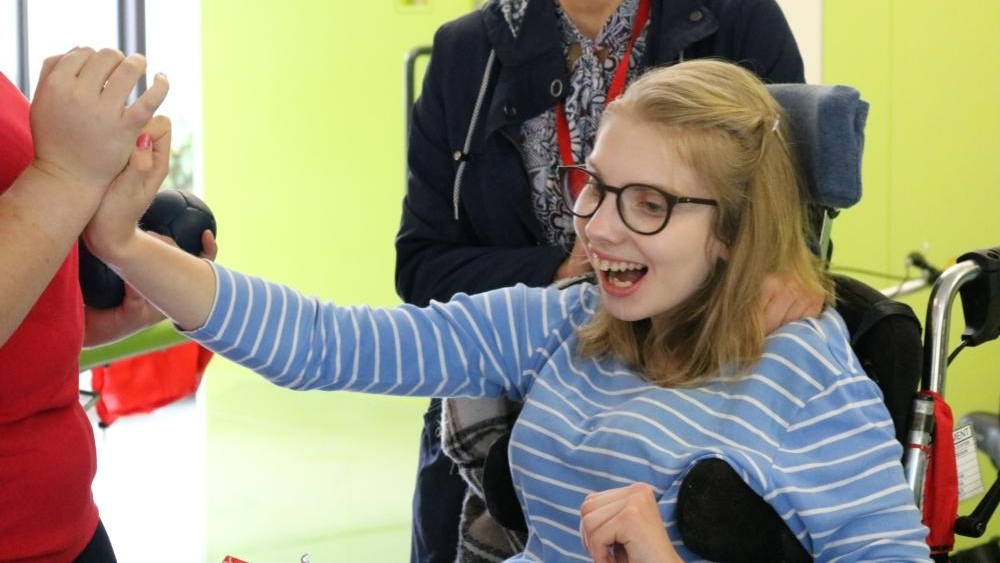
Residential rehabilitation
We offer a range of residential brain injury rehabilitation services for children and young people with acquired brain injury (ABI).
Lewis, aged 13, has had a number of strokes since the age of seven and a brain haemorrhage in 2019. Mum Sharon shares their story.
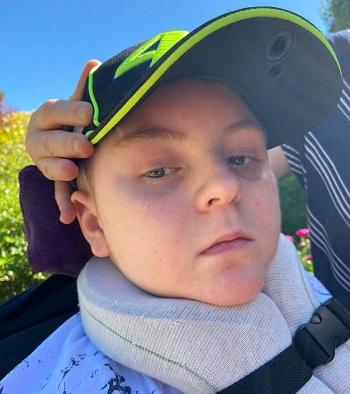
Published: January 2021. Date of brain injury: 2014 (aged 7) and 2019 (aged 12).
Our son Lewis communicates with us by blinking. He is in a minimally conscious state so we don’t know what he is aware of, but he is making small improvements. Lewis is unable to move his limbs voluntarily and is registered severely sight impaired (we think he can see light/dark and possibly colours). He is fed and given his meds by tube directly into his stomach.
Lewis lives at home with us. He’s spent a lot of time in hospital but has been back at home since September 2020. Challenges include providing Lewis with the things that we take for granted every day, like access to a bath or shower, and a comfy chair to sit in the lounge to enjoy some family time. Because of this, our friends started a fundraising page as Lewis can only access two rooms due to the size of his wheelchair, and this doesn’t include any bathroom facilities.
Lewis has spent a lot of his life in Alder Hey Children’s Hospital after suffering a stroke at the age of seven and associated life-threatening complications. My friend said: “Lewis is the toughest, most determined boy his friends and family have the honour to know. He fights every day to gain more movement.”
Lewis was born in April 2007, a healthy boy who grew up enjoying a whole range of activities including swimming and Taekwondo, but his favourite was his scooter!
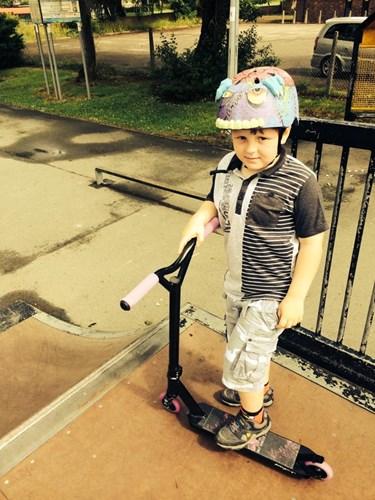
In 2014, at the age of seven, everything changed when Lewis suffered an acute left middle cerebral artery stroke, which affected the right side of his body rendering him unable to walk, talk or even eat. In Alder Hey, Lewis spent four months relearning how to talk and eat and eventually was able to walk again. This gave us an early insight into Lewis’s fighting spirit, coming back from the stroke with such determination!
After undergoing tests while in hospital, Lewis was diagnosed with a very rare vasculitic disease called Pan Vasculitis, which affected his brain, liver, kidneys, spleen and bowel, and without treatment would result in organ failure. Lewis began chemotherapy, and a high dose of steroids for seven months, which thankfully appeared to stop the disease in his organs. However, the disease returned the following year, in his brain this time, resulting in more drugs to try and control the disease.
Lewis, being the fighter he is, continued with school as much as possible throughout treatment and loved spending time at his caravan with his family and friends – he would happily pay the penalty of spending a few days recovering from the exhaustion to spend a Saturday afternoon running around with his friends, playing in the river, playing football and laughing around the fire at night toasting marshmallows.
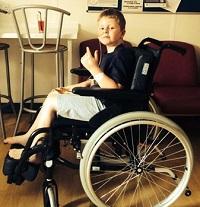
Over the years, Lewis’ condition seemed to stabilise, at some point even recovering. However, in 2019 a routine MRI showed that whilst the Pan Vasculitis was no longer active, it had caused damage to the blood vessels in his brain. This was causing Lewis to have mini strokes that would eventually cause larger strokes. Lewis was increasingly tired by small periods of activity and no longer had the energy to attend school full time.
Lewis’s situation meant he needed revascularisation surgery, on both sides of his brain, an extremely rare operation. In November 2019, he underwent a 10-hour surgery. Lewis came round after the surgery, but unfortunately that night suffered a further three strokes, this time affecting the left side of his brain and his speech.
After intensive care for a week, Lewis was transferred to a ward in Alder Hey for rehabilitation. He again lost his speech and movement but two weeks later he began to talk, asking me if he’d had another stroke, and his cheeky giggle returned. He looked forward to his physio everyday so he could learn how to use his left arm and walk again. Once again, Lewis amazed everyone there with his determination.
However, on the 28 November 2019, the artery that had been used on the left side of Lewis’ brain in the surgery tore, resulting in an acute severe haemorrhage which shunted his brain to the right side of his head. Lewis was rushed into surgery in the early hours and we were told he may not survive.
Following the surgery, Lewis was placed in an induced coma in intensive care; at this point it wasn’t known how much damage had been sustained and whether Lewis would be able to breathe on his own. If the bleed had happened anywhere other than in the hospital, the chances of survival would have been slim to none.
Lewis remained in intensive care until the week before Christmas and after many difficult episodes, amazingly he started to breathe on his own as they lowered the ventilation. This was the glimmer of hope everyone had been waiting for and the chance for Lewis once again to prove there was no stopping him.
An MRI scan at the beginning of 2020 showed that the bleed had caused Lewis to suffer severe brain injury and is unlikely to make much recovery so in June he was transferred from Alder Hey to The Children’s Trust in Surrey for rehabilitation.
Lewis took part in lots of different types of therapies and attended school. The incredible staff helped us to learn how to look after Lewis and made us believe that we could give him as normal a life as possible at home. We had spent seven months in one room at Alder Hey so for the first time Lewis could go out in a wheelchair. We were supported as a family and during Lewis’ therapy sessions we learnt how day-to-day activities could be adapted so that we could continue them at home.
The staff were so encouraging, always cheering Lewis on. They also supported us in coming to terms with what had happened to Lewis and making plans for the future, which seemed impossible at the time. The staff helped us with everything from how to wash and dress Lewis, how to give his medication, make sure he was positioned properly... this list goes on. We were so much more confident taking Lewis home when we left.
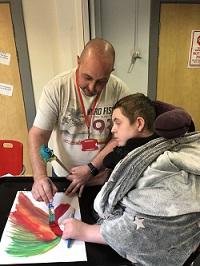
Lewis returned home in September 2020 and his Dad is his full-time carer, while I juggle work and caring for Lewis. As I said, he’s making small improvements. But he now suffers from dystonia, which causes his muscles to contract uncontrollably and can be very painful. Water really helps Lewis’ muscles to relax and he seems to enjoy having his arms and legs moved.
As a family, we simply want Lewis to be able to do what other children do – sit together and watch a movie, enjoy spending time in the lounge or kitchen together, but this proves difficult as Lewis can only sit in his wheelchair or in bed.
Lewis can’t hold his trunk or his head up, so he needs to wear a spinal brace and neck brace to sit in his wheelchair, which is not comfortable for long periods of time. We look forward to him having his own seat within the family lounge so he can be comfortable with us and spend more time in other areas of the home.
It’s hard that the items we need are so costly, which is why our friends set up a fundraising page, calling themselves ‘Lewis's Dream Team’. There is some help to come from the council, and some local businesses have offered their support, but as any parent in this situation knows, you cannot get what you need easily.
We look forward to altering our home, and our garden, and see Lewis enjoying himself and being able to spend more time with the family. He really is amazing and we are so proud of him.

We offer a range of residential brain injury rehabilitation services for children and young people with acquired brain injury (ABI).
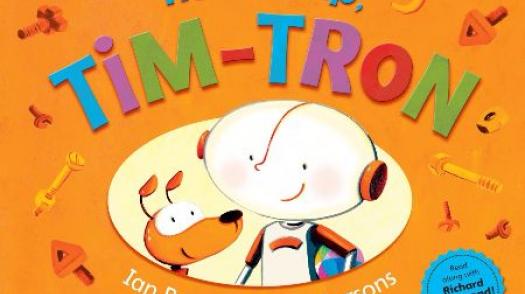
Our series of free books and resources aimed at children and families (P&P costs only).